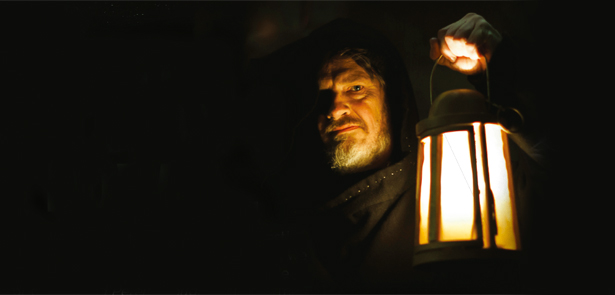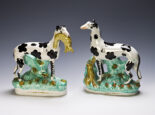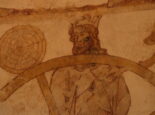When Peterborough’s past won’t lie down…

Something old, something new, something beastly and something blue... As Halloween approaches, we take a tour of local spooks with Peterborough Museum's Horror Night guide and author of Haunted Peterborough, Stuart Orme
‘It’s an old building, and you get to know its sounds,’ says Stuart Orme. ‘But every once in while when I was there in the evening on my own I’d hear someone walking around upstairs. It’s just as if there were a visitor or a colleague up there – and yet I knew damn well I was the only one there…’ Stuart is talking about Peterborough Museum – renowned as the most haunted building in the city – where he worked as Events and Programmes Manager for a number of years (he’s now curator of the Cromwell Museum). A historian by training, he is naturally sceptical of anything that is not supported by evidence or reliable testimony. And yet he retains a fascination for the inexplicable – and has himself been witness to things he can’t quite explain, as we shall see.
It is supposed that Halloween is the Christianised version of the pagan Celtic festival of Samhain, when the veil between this world and the next was at its thinnest, and things could drift through. So to get in the Halloween mood – and perhaps sound a note of warning – we present our own pick of local ghost stories from around the region, starting with one that is very old indeed…
Something old: The Three Living and the Three Dead
For us, ghosts are spirits that appear and disappear and can pass through solid objects. As one goes further back into history, however, they become more solid, more physical. The Three Living and the Three Dead is a medieval zombie story. Whilst not exactly a local tale, it has local connections: at Longthorpe Tower we have a medieval wall painting that Stuart describes as: ‘probably one of the most remarkable and well-preserved depictions of that story’. The story itself, told and retold in many variations, was hugely popular during the 14th and 15th centuries as a reflection on mortality – and as a warning.
One day, three proud kings were out hunting boar. Riding ahead of their retainers, they became lost in a mist, which separated them from the main hunting party. Then, emerging from the dark edge of the forest, they saw three figures. They walked stiffly, as if barely able to move their limbs, and as the figures lumbered closer, the kings drew back in horror. They were dead men, each in a different state of decay. One, only recently deceased, had grey flesh and blue lips. Another was rotting and crawling with maggots. The third – an emaciated cadaver with staring, lidless eyes – was little more than a skeleton. The kings were terrified, uncertain whether to flee or to stand and fight these horrors. Then the dead addressed them. They were not demons, they said, but the kings’ forefathers, whose memory had been cruelly neglected. Each urged the living to live better lives, and to remember them. ‘Such as you are,’ they said, ‘we once were. Such as we are, you will be.’ The dead departed as dawn came, and the kings rode home, where they said masses for their dead ancestors in the church, and had their story written on its walls.
‘This story wasn’t meant to be depressing,’ says Stuart. ‘It came from a time of high mortality, and was more a message of carpe diem – sieze the day. It was given some prominence at Longthorpe by the Thorpe family, so obviously was an important message to them. Those paintings date from around 1320- 1340, so within a generation there’s mortality on a massive scale.’ In 1348 the Black Death arrived, and ultimately wiped out a third of the population. Carpe diem indeed.
Something new: The Old Lady of Meynell Walk
Now we shift forward several centuries to more familiar times. Our times. Perhaps you think you are safe because you avoid lonely roads, and the old places? Think again. On Meynell Walk in Netherton – housing built by the Development Corporation in the 1970s – there is a house that never seems able to keep a tenant. The original occupant, it seems, was an elderly lady who died in the property in the mid-1980s, and ever since then has kept coming back.
Stuart Orme takes up the story: ‘Her ghost has been seen in the conservatory at the back of the house on a number of occasions. What is particularly unnerving, however, is her habit of visiting children when they’re in bed at night. That may sound quite sweet, but imagine you are eight years old, tucked up in bed, fast asleep, and you wake up to hear your bedroom door open, and then footsteps come into your room. They walk to the bottom of your bed, and you feel someone sit down on it. Finally you pluck up the courage to pull back the duvet and have a look, but there’s no one there – just the weight on the bed and the depression in the covers where they ought to be.’ Stuart adds: ‘This removes the ghost story from the traditional safe zone of an old building, like a museum, cathedral or castle. It’s a contemporary building, and somebody’s house – one of those “it could be you” moments.
Something beastly: Black Shuck
It’s not just insubstantial spirits or things in human form that haunt us. Sometimes, there are monsters. There are tales of phantom black dogs in almost every county of Britain. He goes by many names – Barghest, Skriker, Padfoot, Hairy Jack, Galleytrot – and even provided the inspiration for Conan Doyle’s Hound of the Baskervilles. In East Anglia and the fens, where he is most active, he is known as Black Shuck, a name believed to derive from the Anglo- Saxon word scucca, meaning ‘devil’ or ‘fiend’ and used in the poem Beowulf to describe the monster Grendel. He is also one of the most persistent phantoms on record; first reported in the middle ages, sightings of him continue to be reported to this day. Shuck is huge and black with eyes that glow like fire, and he haunts graveyards and lonely roads – especially crossroads, or where highways cross water. He brings death with him. Some stories speak of his ability to strike dead those he touches, as he did in the churches of Blythburgh and Bungay in the year 1577.
Legend has it that simply seeing him upon the road means you will know death by morning. Peterborough’s place in the history of this fiend is a special one, for, according to some traditions, it was an Abbot of Peterborough Abbey who unwittingly unleashed him upon the world. In the year 1127, Henry of Poitou was appointed Abbot by Henry I, and immediately proceeded to start milking the Abbey for personal gain. From the moment of his arrival, however, the portents were bad, as the contemporary Peterborough Chronicle (a continuation of the Anglo-Saxon Chronicle, written at Peterborough Abbey) describes: Let no-one be surprised at the truth of what we are about to relate, for it was common knowledge throughout the whole country that immediately after [Poitou’s arrival] many men both saw and heard a great number of huntsmen hunting. The huntsmen were black, huge and hideous, and rode on black horses and on black he-goats and their hounds were jet black and loathsome with eyes like saucers.
This was seen in the very deer park of the town of Peterborough and in all the woods that stretch from that same town to Stamford, and in the night the monks heard them sounding and blowing their horns. Reliable witnesses who kept watch in the night declared that there might well have been as many as twenty or thirty of them blowing their horns as near they could tell. This was seen and heard from the time of his arrival all through Lent and right up to Easter. It was said one of these black hellhounds remained as punishment for allowing the Abbey to fall into the hands of so evil a man – and a warning that it must never happen again.
Something blue: The Lady in the Corridor
This one has a special place in our tour – because it is something Stuart saw with his own eyes in the Museum, one night in 2013. ’We were setting up the Belle Epoque exhibition showing original Edwardian costumes,’ says Stuart, ‘and myself and two colleagues were working late one Thursday inside the gallery, getting ready for the opening. One of us was on the other side of the room setting up some graphics; the other was fixing a wall hanging up a ladder, and I was footing the ladder for her. Nothing out of the ordinary.’ As Stuart stood there, he happened to glance across at the door leading out onto the ground floor corridor.
‘This woman walked past the doorway. I’d never seen her before in my life. She wasn’t a member of staff or a visitor. The building was all locked up and I knew we were the only people in it.’ This ghost did not fit the stereotype, however. ‘She wasn’t a grey, misty figure – she looked like a living, breathing person. She was about 40 years old, hair pulled back in a bun, dressed in a dark blue Victorian style dress with a white apron or pinny on the front. And she just walked past the door. My colleagues were looking in the other direction, so didn’t see anything. I sort of coughed and they said: “Are you all right?” I said: “Hang on a minute…” shot to the door and looked out into the corridor. But there was absolutely nobody there. The door was locked.’
He shrugs. ‘It’s just one of those things. Buildings have memories.’ As with so many ghosts, this one seems tied to a specific location. ‘Lots of colleagues over the years have reported footsteps in that corridor, or glimpsing someone moving past the doorway, and then they look and there’s nobody out there. When we’ve had ghost hunters stay in the building overnight, sometimes they’ve reported similar experiences.’ Could something similar happen to you? Upon a lonely road? In an empty building at night? Safely tucked in your bed? Perhaps it could. Happy Halloween!
Peterborough Museum 2022 Halloween Programme:
- Priestgate Vaults tour Sat 22 Oct 11am & 2:30pm
- Candlelit tour of Peterborough Museum Mon 24 Oct 7:30pm
- Priestgate Vaults tour Tue 25 Oct 11am
- Candlelit tour of Peterborough Museum Tue 25 Oct 7:30pm
- An evening in the Priestgate Vaults Wed 26 Oct 7pm & 8pm
- Priestgate Vaults tour Thu 27 Oct 11am
- Halloween Ghost Walk Fri 28 Oct 7:30pm & 8pm
- Priestgate Vaults tour Sat 29 Oct 11am & 2:30pm
- Halloween Ghost Walk Sat 29 Oct 7:30pm & 8pm
- Halloween Horror Night Sat 29 Oct 6:30pm, 7pm, 7:30pm, 8pm, 8:30pm, 9pm
- Halloween Ghost Walk Sun 30 Oct 7:30pm & 8pm
- Family Halloween Ghost Walk Mon 31 Oct 4:30pm
- An evening in the Priestgate Vaults Mon 31 Oct 7pm
- Candlelit tour of Peterborough Museum Mon 31 Oct 7:30pm
For more information and to book tickets for all events visit: peterboroughmuseum.org.uk/events/halloween
● Stuart Orme’s book Haunted Peterborough is available from Amazon















